
By
Leanna Seah
September 20, 2024
Updated
October 17, 2024

Employment trends and job market analysis
With a GDP of more than USD$20 trillion, the United States is a leader in several key industries, including technology, oil and gas and renewable energy.he U.S. hosts one of the largest and most influential tech markets, with four cities consistently ranking in the top 10 for global fintech, including Silicon Valley (#1) and Boston (#7).
Ranked sixth globally for ease of doing business by the World Bank, the U.S. continues to offer a dynamic landscape for innovation-driven enterprises.
The nation's stable economic foundation and focus on emerging technologies, such as artificial intelligence (AI) and sustainability, make it an attractive destination for international business expansion.
However, entering the U.S. market presents challenges. Businesses need to navigate a complex regulatory environment and adapt to the unique demands of American consumers and the competitive workforce.
The U.S. labor force is central to its economic vitality. While the post-pandemic recovery has seen gains in employment, the effects of the "Great Resignation" persist in 2024. Many workers have reassessed their careers, opting for better work-life balance, hybrid work arrangements, or entirely new fields.
Industry-specific growth
-
Technology & AI: The tech industry, driven by advances in AI, cloud computing, and cybersecurity, continues to fuel job creation. The demand for AI ethics and governance professionals is rising, aligning with emerging regulations, including the EU’s AI Act and the growing emphasis on ethical AI development.
-
Transportation & warehousing: This sector experienced notable growth during the pandemic, with an average increase of 23,000 jobs per month. By 2024, trucking jobs have stabilized above pre-pandemic levels, and warehouse employment has grown by over 60%, supported by the ongoing e-commerce boom.
-
Renewable energy: Renewable energy, particularly wind and solar, is another significant area of growth. The Inflation Reduction Act and increased corporate sustainability commitments are driving investments in green energy, creating a surge in demand for renewable energy jobs.
-
Manufacturing: While the manufacturing sector maintains one of the lowest unemployment rates, standing at 2.6%, it faces a persistent shortage of skilled labor. Even with an increase in vocational training and reskilling programs, the sector struggles to fill positions, especially in durable goods manufacturing. Automation is expected to partially offset the labor gap, but the need for skilled human labor remains pressing.
| Capital | Washington D.C |
| Languages spoken | English |
| Population size | 333.3 million |
| Payroll frequency | It depends on the employer. The most common are weekly, semi-monthly or biweekly. |
| Currency | United States Dollar (USD) |
| VAT |
Nil |
Labour laws to be aware of when hiring employees
Hiring employees in the United States involves compliance with a range of federal and state labour laws. Below are some important labor laws to be aware of:
1. Fair Labor Standards Act (FLSA): The FLSA sets the federal minimum wage, overtime pay requirements, and rules for child labor. It also defines the criteria for classifying employees as exempt or non-exempt from overtime pay.
2. Family and Medical Leave Act (FMLA): The FMLA requires certain employers to provide eligible employees with up to 12 weeks of unpaid, job-protected leave for specific family and medical reasons, including the birth or adoption of a child, serious health conditions, and caring for a family member with a serious health condition.
3. Occupational Safety and Health Act (OSHA): OSHA mandates that employers provide a safe and healthy workplace for employees. It establishes standards for workplace safety and health, as well as guidelines for reporting and addressing workplace injuries and illnesses.
4. Immigration Reform and Control Act (IRCA): Employers must verify the identity and employment eligibility of all employees hired after November 6, 1986. This is typically done using the Form I-9, which verifies an employee's eligibility to work in the U.S.
5. National Labor Relations Act (NLRA): The NLRA governs the rights of employees to engage in collective bargaining and protects their rights to form, join, or assist labor unions.
6. Employee Retirement Income Security Act (ERISA): ERISA sets standards for employee benefit plans, including retirement and health plans, to ensure they are managed in a fair and responsible manner.
7. Worker Adjustment and Retraining Notification Act (WARN): Employers with a certain number of employees must provide advance notice of mass layoffs or plant closings under the WARN Act.
8. State Labor Laws: In addition to federal laws, each state has its own set of labor laws that cover areas such as minimum wage, overtime, paid sick leave, and other employment-related issues. It's important to be familiar with both federal and state laws to ensure full compliance. We'll cover this in more detail later in the guide.
Remember that labor laws can be complex and subject to change. It's advisable to consult with legal counsel or human resources professionals to ensure you're following all relevant laws and regulations when hiring and managing employees in the United States.
Payroll and taxes
Payroll tax in the United States is imposed separately by the federal and state governments. Federal income tax is governed by the Internal Revenue Service (IRS).
Both employers and employees are subject to payroll taxes that are collected by the employer per payroll and remitted on a quarterly or annual basis to the taxing jurisdiction.
Employer contributions
Mandatory contributions for employers in the United States currently comprise of:
Unemployment taxes
Imposed by the Federal Unemployment Tax Act (FUTA), employers are required to report this tax by annually filing Form 940 with the IRS. As of June 2011, the current unemployment tax rate stands at 6.0% and can be reduced to a rate of up to 5.4% through credits earned through contributions to state unemployment programs under sections 3302(a) and 3302(b) in FUTA.
On a state level, employers are also required to pay a payroll tax under the State Unemployment Tax act (SUTA), also known as State Unemployment Insurance (SUI). The funds are channelled into the state unemployment fund on behalf of their employees.
In states such as Alaska, New Jersey, and Pennsylvania, both employer and employee are required to pay SUTA taxes. SUTA rates are assigned to each individual employer and are based on variables such as years of experience and type of industry.
Social security
Funded by the Federal Insurance Contributions Act (FICA) tax, social security is a federal government program that provides benefits for retirees, individuals with disabilities, and surviving children of deceased workers.
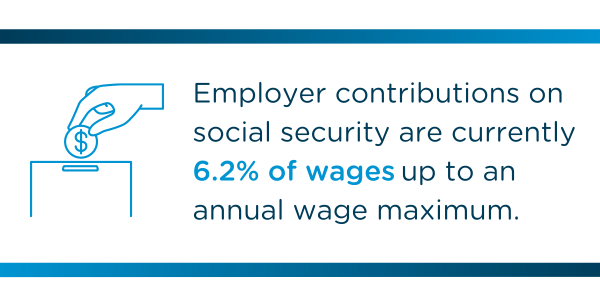 Some of the benefits offered under the Social Security Administration (SSA) include retirement insurance, prescription drug benefits, and public assistance and welfare services. Employer contributions on social security are currently 6.2% of wages up to an annual wage maximum.
Some of the benefits offered under the Social Security Administration (SSA) include retirement insurance, prescription drug benefits, and public assistance and welfare services. Employer contributions on social security are currently 6.2% of wages up to an annual wage maximum.
Medicare
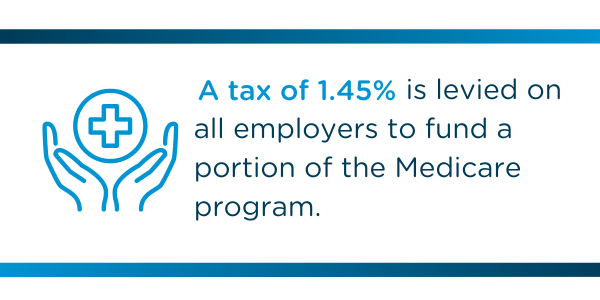
Medicare is a government health insurance program that provides health insurance for Americans above 65 years old as well as younger individuals with disability status as determined by the SSA. Employers are required to contribute 1.45% of wages to support the Medicare program, ensuring that Americans have access to essential healthcare services.
State disability benefits
Several states, including New York, New Jersey, and California, require employers to provide disability benefits to workers that cover injuries or illness not caused by an accident in the workplace. In some states, employers make payments into a state fund which channels these benefits to the employees, while in others, the employee may purchase an insurance coverage plan from an authorised provider or the state. Disability benefits can be funded:
- Entirely by the employer
- Via deductions from the employee's wages
- As a combination of the above
Workers compensation insurance
Workers’ compensation is generally to protect employees who sustain workplace injuries and is put in place to protect employers from various tort claims made by employees. Private employees with one or more employees are expected to provide workers’ compensation insurance by most American states however it is optional in some states, such as Texas. In several states, employers are allowed to be self-insured for workers’ compensation.
Employee tax contributions in the USA
Mandatory deductions for U.S. citizen employees include:
- Withholding of U.S. Federal, State, and local income taxes
- Deduction for U.S. Social Security taxes, Foreign Service retirement, Civil Service retirement, Federal Employees’ Group Basic Life Insurance (FEGLI), Federal Employees Health Benefits (FEHB)
- Any court-ordered garnishments and bankruptcy payments
The table below illustrates a breakdown of federal, state, and local taxes across the United States:
| What is it | How it works | Who’s responsible |
|---|---|---|
| Federal income tax | Federal income tax is withheld from an employee’s paycheck each time the employee receives their salary. The tax rate is determined by withholding tables that are published yearly by the IRS. |
The employer is responsible for withholding federal income tax from the employee’s check during each payroll cycle. |
| Federal Insurance Contribution Act (FICA) | Includes both Medicare and social insurance taxes. Rates are reviewed annually. |
FICA taxes are split evenly between employer and employee. The employer is responsible for withholding the employee amount during each payroll cycle. |
| Federal Unemployment Tax (FUTA) | FUTA is a payroll tax that funds unemployment programs in the United States. | FUTA taxes are 100% borne by the employer. Employees may receive credit on their FUTA taxes based on their SUTA tax payments. |
| State Income Tax | All states with the exception of Alaska, Florida, Nevada, South Dakota, Texas, Washington and Wyoming have a state income tax. | The employer is responsible for withholding state income tax from the employee’s paycheck during the payroll cycle. |
| State Unemployment Tax (SUTA) | SUTA is a payroll tax that funds unemployment programs for each individual state. | SUTA taxes are borne by the employer in most states apart from Alaska, New Jersey and Pennsylvania, where it is borne by both the employer and the employee. |
| Local taxes | Can include local income, school board, transit, municipality or almost any other kind of tax. | Responsibilities vary depending on the tax authority and the type of tax. |
Table adapted from wagepoint.com
All income made by U.S citizen employees is subject to Federal income tax and social security taxes. Deductions are also mandatory on local retirement, life, health, or other benefits when coverage is required by local law.
Which states have local payroll taxes?
Eight states (Alabama, Colorado, Delaware, Kansas, Kentucky, Missouri, Pennsylvania, and West Virginia) opt for the direct collection method for managing local income taxes. Indiana, Iowa, Maryland, and New York employ the piggyback method. Minnesota, New Jersey, Ohio, and Oregon employ a combination of the two by either adopting the state income definitions or collecting the tax on the local level.
The minimum wage
The federally mandated minimum wage in the United States is USD$7.25 per hour, according to the U.S. Department of Labor (DOL). However, the minimum wage varies according to State. The District of Columbia currently has the highest minimum wage in the U.S. (USD$17.50 per hour) as of January 2024, followed by California (USD$16 per hour), with further increases in certain cities like San Francisco and Los Angeles.
The table below illustrates the current minimum wage rates across the different states as of 2024.
| State | Minimum Wage |
| Alabama | $7.25 |
| Alaska | $11.73 |
| Arizona | $11.00 |
| Arkansas | $11.00 |
| California | $16.00 |
| Colorado | $14.42 |
| Connecticut | $15.69 |
| Delaware | $13.25 |
| District of Columbia | $17.50 |
| Florida | $12.00 |
| Georgia | $7.25 |
| Hawaii | $14.00 |
| Idaho | $7.25 |
| Illinois | $14.00 |
| Indiana | $7.25 |
| Iowa | $7.25 |
| Kansas | $7.25 |
| Kentucky | $7.25 |
| Lousiana | $7.25 |
| Maine | $14.15 |
| Maryland | $15.00 |
| Massachusetts | $15.00 |
| Michigan | $10.33 |
| Minnesota | $8.85 for small employers $10.85 for large employers |
| Mississippi | $7.25 |
| Missouri | $12.30 |
| Montana | $10.30 |
| Nebraska | $12.00 |
| Nevada | $12.00 |
| New Hampshire | $7.25 |
| New Jersey | $13.73 (seasonal and small employers) $15.13 (all other employers) |
| New Mexico | $12.00 |
| New York | $15.00 $16.00 (NYC, Long Island and Westchester Country |
| North Carolina | $7.25 |
| North Dakota | $7.25 |
| Ohio | $7.25 $10.45 (employers with annual gross receipts of $385,000 and up) |
| Oklahoma | $7.25 |
| Oregon | $13.20 ( non-urban countries) $14.20 (standard state rate) $15.45 (Portland metro area) |
| Pennsylvania | $7.25 |
| Rhode Island | $14.00 |
| South Carolina | $7.25 |
| South Dakota | $11.20 |
| Tennessee | $7.25 |
| Texas | $7.25 |
| Utah | $7.25 |
| Vermont | $13.67 |
| Virginia | $12.00 |
| Washington | $16.28 |
| West Virginia | $8.75 |
| Wisconsin | $7.25 |
| Wyoming | $7.25 |
Average salary
The average salary in the United States varies across a variety of factors including industry, age group, educational background, job position and level of experience.
Working hours
Working days in the United States typically run between 9 am to 5 pm from Mondays to Fridays. This represents a five-day work week with an average of 40 hours per week. Employees covered by the Fair Labor Standards Act (FLSA) are entitled to overtime pay at a rate that is no less than one and a half times their regular pay rate for overtime hours worked during a 40-hour work week.
Employee benefits
Most employers in the United States provide their workforce with benefit plans as an incentive to increase corporate retention and employee satisfaction. Also referred to as fringe benefits, common additional benefits typically found in the USA often include:
- Retirement benefit plans (such as 401(k), pension and long-term care insurance)
- Paid time off (PTO) such as vacation leave and sick leave
- Relocation assistance
- Medical, prescription, vision, and dental plans
- Flexible spending accounts (FSA) such as Health and Dependent Care FSAs
- Legal assistance plans
- Adoption assistance
- Childcare benefits
- Transportation
Check out our webinar below on Employee Benefits in the US and join us as our experts discuss the employee benefits for employees in the US for organisations expanding globally.
Many employers in the United States also go as far as to provide their staff with Employee Discount Programs that provide workers with access to specialised discounts on products and services from different vendors. These programs can include discounts on hotels and holiday destinations, beauty and wellness treatments, financial services, movie and theme park tickets, and home services.
Most of these benefits are tax deductible for the employer and not subject to income tax for the employee.
Cafeteria plans are also a popular benefits scheme offered by American employers to their employees according to the requirements of section 125 in the Internal Revenue Code. These plans often include a “menu” of different levels of benefits for the employee to choose from on a pretax basis. Employees on a cafeteria plan must be allowed to choose one taxable benefit and one qualified benefit.
A qualified benefit refers to any type of benefit that is excluded from an employee’s taxable income and includes:
- Accident and health benefits (excluding Archer medical savings accounts or long-term care insurance)
- Adoption assistance
- Dependent care assistance
- Group-term life insurance coverage
- Health savings accounts (Including distributions to pay for long-term care services)

Source: Shutterstock/prostock-studio
Employee rights
In the United States, employees are granted several rights and protections under federal and state laws. Some of the key employee rights include:
Equal Employment Opportunity (EEO)
Employees have the right to be free from discrimination and harassment based on factors such as race, color, religion, sex, national origin, age, disability, and genetic information. This includes protections against unfair treatment in hiring, promotion, compensation, and other employment-related decisions.
Fair compensation and overtime
Employees have the right to receive at least the federal or state minimum wage (whichever is higher) for their work. Non-exempt employees are entitled to overtime pay (usually 1.5 times their regular pay rate) for hours worked beyond 40 in a workweek.
Safe and healthy workplace
Employees have the right to work in an environment that is free from recognised hazards that could cause serious injury or death. Employers are required to comply with Occupational Safety and Health Administration (OSHA) standards to ensure workplace safety.
Family and medical leave
Eligible employees have the right to take unpaid leave for certain family or medical reasons under the Family and Medical Leave Act (FMLA). This includes leave for the birth or adoption of a child, serious health conditions, and caring for family members with serious health conditions.
Freedom from retaliation
Employees have the right to report workplace violations, health and safety concerns, and other legal issues without facing retaliation or adverse employment actions.
Right to organise and collective bargaining
The National Labor Relations Act (NLRA) protects employees' rights to form, join, or assist labor unions and engage in collective bargaining with employers.
Right to accommodation
Under the Americans with Disabilities Act (ADA), employees with disabilities have the right to reasonable accommodations to perform their job duties, as long as these accommodations do not impose undue hardship on the employer.
Right to review personnel records
Some states grant employees the right to access their personnel records to ensure accuracy and transparency.
Right to protected activities
Employees have the right to engage in certain protected activities, such as filing complaints with government agencies, participating in investigations, and opposing discriminatory practices without facing adverse consequences.
It's important to note that employee rights may vary by state, industry, and specific circumstances.
Types of leave available
Federal law does not require private employers in the United States to provide employees with paid time off, vacation or sick days however, many employers choose to do so. It's also important to know that leave allowance may vary depending on contract vs. permanent roles.
Sick leave
There are no federal requirements for paid sick leave. However, the FMLA mandates up to 12 weeks of unpaid leave for certain medical situations involving the employee or their immediate family. In some cases, paid leave can replace unpaid FMLA leave.
To be eligible for FMLA, employees must have worked for the employer for at least 12 months, clocked 1,250 hours in the past year, and be employed at a location with at least 50 employees within 75 miles.
Family and medical leave (FMLA)
The United States FMLA leave scheme provides employees with up to 12 weeks of unpaid leave per year. During this time, the employees’ jobs, along with any group health benefits, are maintained.
Eligible employees are entitled to:
- Twelve weeks of leave within a 12-month period for:
- Childbirth and care for a newborn child within a year of the birth
- Care of an adopted or a foster child that has been placed within the employee’s care within one month of said placement
- Care of a parent, spouse, or child facing serious medical conditions
- Serious medical conditions that affect the employee’s ability to perform the essential functions of their job
- Any qualifying exigency arising out of the fact that the employee’s spouse, child, or parent is a covered military member on “covered active duty;” or
Twenty-six weeks of leave during a single 12-month period to care for a covered servicemember with a serious injury or illness if the eligible employee is the servicemember’s spouse, son, daughter, parent, or next of kin. This is known as military caregiver leave.
Employees are eligible for FMLA if they have worked for their employer that employs 50 or more employees within 75 miles for a minimum of 12 months.
Paid time off (PTO)
There is no federal requirement for paid time off in the United States, according to the Department of Labor. PTO is usually regulated according to state laws, or oftentimes, it is up to the company to determine its own PTO policies.
Currently, only twelve states, along with Washington DC, have legislated paid sick leave.
- Workers in Arizona, California, Maryland, Michigan, New Jersey, and Oregon earn an hour of PTO for every 30 hours of service.
- Workers in Connecticut, Washington, Maine, and Nevada earn one hour of PTO for every 40 hours of service.
- Workers in Rhode Island earn one hour of PTO for every 35 hours of service.
- Workers in Washington, D.C, earn one hour of PTO for service between 37 to 87 hours, depending on the size of the business.
Funeral and bereavement leave
The USA''s Fair Labour Standards Act (FLSA) does not provide payment for any time off taken to attend a funeral. This benefit is typically based on an agreement between the employer and the employee. Most companies in the USA typically provide between one to five days of bereavement leave, with most HR policies providing an average of three days.
Public holidays
There are currently 11 calendar dates that the US Government has declared as federal holidays. Holiday dates that fall on a weekend are typically observed on the closest preceding or succeeding weekday.
The list below shows the public holidays observed by all regions in the USA.
- New Year’s Day – January 1
- Martin Luther King Jr. Day – Third Monday in January (January 15-21)
- Presidents' Day (George Washington’s Birthday) – Third Monday in February (February 15-21)
- Memorial Day – Last Monday in May (May 25-31)
- Juneteenth National Independence Day – June 19
- Independence Day – July 4
- Labor Day – First Monday in September (September 1-7)
- Columbus Day – Second Monday in October (October 8-14)
- Veterans Day – November 11
- Thanksgiving Day – Fourth Thursday in November (November 22-28)
- Christmas Day – December 25
Are background checks mandatory?
There is no federal law that mandates employee background checks. However, many companies prefer to screen potential candidates prior to making an offer for various reasons that include: verifying their previous work credentials, minimising risk for the company, and keeping their workplace safe.
There are, however, various regulations that govern the ways in which background checks are conducted.
For example, employers using a consumer reporting agency (CRA) must follow the rules established by the Fair Credit Reporting Act (FCRA), which requires employers to inform and receive consent from potential employees before conducting a background check.
Under the FCRA, the employer must obtain the employee's written consent to obtain any background information and the potential employee is allowed to review the results of the background check and dispute any inaccuracies and act against employers that violate the FCRA.
Many state and local governments across the USA have also enacted “ban the box” laws that prohibit employers from asking job applicants and employees about their criminal history. As of 2021, 37 states, the District of Columbia and more than 150 cities and counties have passed some form of ban the box legislation.
In California, for example, employers are prohibited from asking job applicants about their criminal history until after a conditional job offer has been extended. This rule applies to all corporations with five or more employees. While Illinois’ ban the box law states that no enquiries about criminal history are allowed prior to the job interview or after a conditional job offer is made if no interview occurs. This, however, only applies to private business owners with 15 or more employees.
The Americans with Disabilities Act (ADA) is also important to take note of. For businesses with 15 or more employees, the ADA prohibits the use of medical information to discriminate against an employee.
According to the ADA, employers cannot subject potential employees to a pre-employment physical before a conditional job offer is extended.
The laws that surround employee background checks exist to protect the privacy of and prevent discrimination against job applicants and employees in the United States. They can, however, be a complex landscape for employers to navigate, especially due to the differences in local, state, and federal laws.
For employers that are planning to screen and hire contractors in the US, consulting with their HR department and doing their due diligence in reading up on the obligations surrounding background checks is the best way to minimise risk during the hiring and remote hiring process.
Minimum retirement age
For American employees born between 1943 to 1954, the full retirement age is 66. This increases gradually for those born between 1955 to 1960 until it reaches 67 years of age. Anyone born from 1960 onwards is entitled to receiving full retirement benefits at age 67.Attracting talent
Understanding what employees want and value is key to defining a talent attraction and retention strategy. Fair pay and good benefits continue to take centre stage; however, various attributes relating to employee well-being and culture have also risen in the ranks.
Companies must find a way to balance the importance of traditional employee values alongside new priorities that have come to the foreground. Making this part of their value proposition to potential employees will help employers optimise their talent attraction and retention strategies.
Here are some important employee values to consider:
A diverse and inclusive workplace
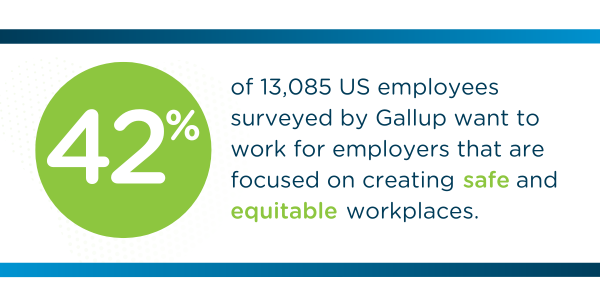
42% of 13,085 US employees surveyed by Gallup want to work for employers that are focused on creating safe and equitable workplaces. And they expect to see accountability in the form of actionable changes that go beyond a performative DEI statement on a website.
According to Gallup, recruiters must be prepared to discuss these actions and commitments as well as answer questions relating to the efforts taken by the company to fulfil their commitment to creating a diverse and inclusive workplace.
Giving employees access to clear and transparent metrics of how a company’s diversity efforts are being measured is key to implementing a DEI policy that is targeted and impactful.
 Source: Shutterstock/Jacob Lund
Source: Shutterstock/Jacob Lund
Flexible working options
By providing employees with greater flexibility, businesses are empowering them to have greater control over their work-life balance.
According to Citrix’s Work 2035 Project’s examination of global working patterns, a staggering 88% of knowledge workers want to work for companies that provide flexibility in working hours and location.
Out of more than 2000 workers surveyed, 500 were employees from the US and what's more, they feel that they are highly likely to relocate from urban cities for roles that allow them to work remotely.
One of the greatest benefits of flexible working conditions is that it gives workers the freedom to choose when and where they work, therefore allowing them to work when they’re at their most productive.
A greater sense of purpose at work
In October 2021, Gartner surveyed more than 3,500 employees around the world and discovered that a sense of personal value and purpose is what a growing number of workers want.
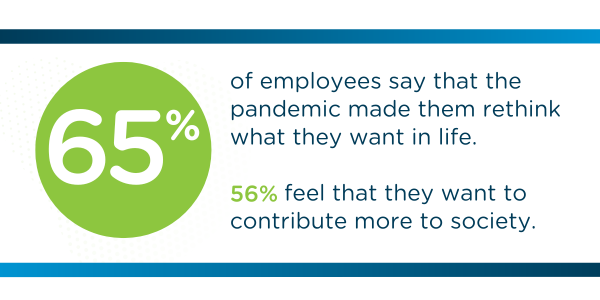
In the workplace, this can translate to growth opportunities, personalised career development programs, and working for businesses that are just as interested in giving back as they are in turning a profit.
Ultimately, employees want work that isn’t purely transactional. Companies that take the time to invest in their employees and connect with them on a more meaningful level will be the ones to successfully attract and retain today’s new wave of talent.
Practical benefits that focus on mental wellness
Since the pandemic, more than 30% of Americans have reported symptoms of anxiety and depression, according to the National Center for Health Statistics. In 2019, this figure was only 10.8%.
The call for better support in the workplace is a resounding one, and according to Harvard Business Review’s 2021 study, more than 91% of respondents feel that mental health support should be part of a company’s culture.
Another survey by HR tech firm Workhuman also showed that 40% of employees would like improved mental health benefits, and 53% of employees feel that providing mental health days would be helpful to employee wellness.
Mental health is at the forefront of employees’ minds, and employers that prioritise this will not only be able to strengthen their talent attraction and retention strategy but also stand to create an enriching dialogue on what employees truly need to thrive in their work and personal lives and contribute to this.
Hiring best practices
Hiring the right employees is crucial for the success of any business. Here are some best practices to consider when hiring employees in the United States.
- In your job postings, clearly outline the job responsibilities, qualifications, and expectations for the role.
- Develop a detailed job description to attract candidates who are the best fit for the position. This could also help you to headhunt passive candidates, who are not actively seeking a new job but might be open to new opportunities if presented with the right offer.
- Use a combination of recruitment methods such as job boards, social media, employee referrals, and professional networks.
- Consider partnering with a global employment outsourcing agency.
- Develop a consistent interview process that includes standardised questions to assess skills, experience, and cultural fit.
- Consider using panel interviews with multiple interviewers to gather different perspectives.
- Assess whether candidates align with the company's values, mission, and work culture.
- Use objective criteria to evaluate candidates, avoiding bias based on age, gender, race, or other protected characteristics.
- Train interviewers to recognise and mitigate bias during the selection process.
- Consider assessing soft skills such as communication, problem-solving, teamwork, and adaptability during the interview process.
- Communicate clearly with candidates about the hiring process and timelines.
- Provide timely feedback to candidates, even if they are not selected.
- Conduct reference checks to gain insights into their work history and performance.
- Ensure compliance with federal and state employment laws, including anti-discrimination laws and immigration requirements.
- Clearly communicate the compensation package, benefits, and any other perks during the staff hiring process.
- Develop a comprehensive onboarding process to help new employees acclimatise to the company's culture, policies, and procedures.
- Regularly review and update your hiring process based on feedback and outcomes to ensure effectiveness.
- Strive to create a diverse workforce by actively seeking candidates from various backgrounds and experiences.
- Consider the long-term growth of the company by evaluating candidates' potential for advancement within the organisation.
By following these best practices, you can enhance the quality of your hires, improve employee retention, and contribute to the overall success of your business.
What should the onboarding process look like for new hires?
The onboarding process for new hires in the United States is a critical phase that sets the tone for their success within your organisation. It's a comprehensive journey designed to integrate employees into the company culture, provide them with essential information, and equip them with the tools they need to excel in their roles.
A well-designed onboarding process typically begins even before the employee's first day. This includes preparing a warm welcome, sending introductory materials, and explaining what to expect on the first day. On the actual start date, there should be an orientation session that covers essential administrative tasks such as completing paperwork, setting up payroll and benefits, and introducing company policies.
Beyond administrative matters, the onboarding process should provide an overview of your company's history, mission, and values. This helps new hires understand the larger purpose and direction of the organisation. They should also receive a clear explanation of their job responsibilities, performance expectations, and key performance indicators. This sets the foundation for their role and performance objectives.
To facilitate integration and networking, new hires should have the opportunity to meet their colleagues, supervisors, and other team members. Regular check-ins during the initial weeks provide opportunities for open communication and addressing any questions or concerns.
Professional development and training play a pivotal role in the onboarding process. Offering comprehensive training sessions that cover both technical and soft skills ensures that employees are equipped to handle their tasks effectively. This may involve formal training sessions, shadowing experienced colleagues, and access to online learning resources.
A successful onboarding process also includes a focus on culture and engagement. Immersing new hires in the company's culture helps them feel connected and motivated. This can involve team-building activities, mentorship programs, and opportunities for involvement in company events and initiatives.
Feedback loops should be established throughout the onboarding journey to gather input from new hires about their experiences. This provides valuable insights for refining and improving the onboarding process.
Essential documents for onboarding employees
- W-4 Form
- i-9 Form
- Offer Letter
- Employment Contract
- Passport or Identification Card of the employee
- State tax witholding form
- Direct deposit authorization form
- Employee handbook acknowledgement
- Emergency contact information
Termination of employment
Under US law, both employers and employees enter a working relationship on an “at-will” basis which also means that either party can choose to terminate the employment relationship for any reason and without notice. This is provided that the ground for termination is not for a discriminatory reason.
In any case, employers should ensure that all employment-related documents, such as employment agreements and company policy handbooks, support the at-will relationship. These documents should:
- Not contain any provisions that create a contract undermining an employee’s at-will status
- Include a disclaimer stating that:
- Disciplinary procedures and policies do not modify the at-will employment relationship and do not create a contract of employment
- The employer maintains the right to skip, repeat or modify disciplinary procedures at its discretion
Small or newly established businesses that don't have formal employment policies should make it a point to ensure that all employee communication reiterates the at-will relationship.
Collective dismissals
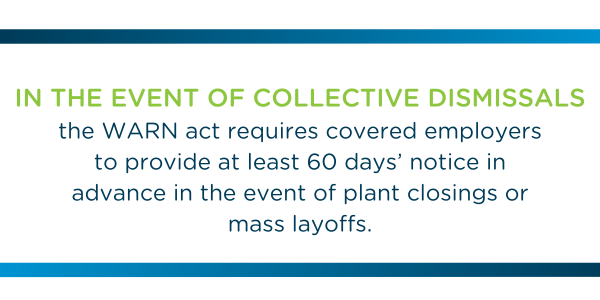
In the event of collective dismissals, the Workers Adjustment and Retraining Notification (WARN) Act required covered employers to provide at least 60 days’ notice in advance in the event of plant closings or mass layoffs to:
- The affected workers or their representatives, i.e., a labour union
- The state dislocated worker unit where the plant closing or mass layoff takes place
- The local chief elected official
This notice is intended to provide workers and their families with time to prepare for potential unemployment, seek out new means of employment, or enter training and upskilling programs to help them successfully compete in the job market.
The WARN act currently covers companies with 100 or more employees. Employees must have worked for a minimum of six months with the same employee and for a minimum of 20 hours within a seven-day work week to be protected by the act.
The act currently does not protect:
- Workers participating in strike actions or that have been locked out in a labour dispute.
- Workers employed on temporary projects or facilities of the business who understand the temporary nature of their work when hired.
- Business partners, consultants, or contract employees assigned to the business but who have a separate employment relationship with another employer and are paid by that other employer or who are self-employed.
- Regular federal, state, or local government employees.
Individual dismissals
There is currently no law dictating a formal procedure when discharging individual employees. In these cases, the termination is subject to whatever agreement is stipulated in the employment contract or collective bargaining agreement.
Severance pay
US federal law does not require employers to offer severance pay. It is usually based on an agreement between the employer and the employee (or the employee’s representative). If severance pay is granted to the employee, the amount is typically determined by their length of employment prior to the termination, and a signed release in favour of the employer is required.
What are my options for hiring?
For businesses that want to hire employees in the United States, Airswift provides a number of employment solutions that will help you hire employees efficiently and compliantly.
We take full administrative responsibilities during the hiring and onboarding process, helping you free up time to focus on other aspects of your business' growth.
Talent acquistion
Partner with an in-county talent acquisition specialist to find local talent in a competitive market.
We also offer contract hire services, for short term projects that require temporary roles and flexible staffing solutions.
For more long-term hiring needs, our professional search services help you discover talented candidates in the United States to fit permanent roles within your organisation.
Suppose you're looking for ways to hire remote workers locally, an Employer of Record in the United States makes it easy to set up a company without having to worry about local laws and regulations.
Employer of record
A trusted Employer of Record allows you to skip the hassle of setting up an actual company and focus on building your business instead.
An EOR can help you oversee local compliance for things like paying employees' salaries, handling their onboarding, and managing their benefits.
*Although the information provided has been produced from sources believed to be reliable, no warranty, express or implied, is made regarding the accuracy, adequacy, completeness, legality or reliability of any information. For the latest information and specific queries regarding particular cases, please contact our team.


